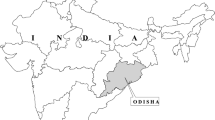Abstract
Vector-borne diseases are feared to extend their range in a future where global warming has occurred. There is considerable concern about scourges such as malaria re-invading currently temperate regions and reaching into higher altitudes in Africa. In this paper we examine the various factors thought to determine potential infectivity of malaria, and its actual outbreak in the context of a dynamic integrated assessment model. We quantify: (i) the role of demographics in placing a larger population in harms way; (ii) the role of climate change in increasing the potential geographic range and severity of the risk of infection; and (iii) the role of economic and social development in limiting the occurrence of malaria. We then explore the climate and economic implications of various climate policies in their effectiveness to limit potential infectivity of malaria. In illustration of these issues we present the climate-related and economics-related impacts of unilateral CO2 control by OECD on incidence of malaria in non-OECD nations. The model presented here, although highly stylized in its representation of socio-economic factors, provides strong evidence of the role of socio-economic factors in determination of malaria incidence. The case study offers insights into unintended adverse consequences of well-meaning climate policies.
Similar content being viewed by others
References
M.H. Babiker, K.E. Maskus and T.F. Rutherford, Carbon taxes and the global trading system (1997) (draft).
M.J. Bouma, S.H.J. van der Kaay and H.J. van der Kaay, Climate change and periodic epidemic malaria, Lancet 343 (1994) 1440–9.
R.N. Cooper, A treaty on global climate change: Problems and prospects, in: Critical Issues in the Economics of Climate Change, eds. B.P. Flannery, K.R. Kohlhase and D.G. LeVine (London, IPIECA 1997) pp. 291–304.
H. Dowlatabadi, Assessing the health impacts of climate change, Climatic Change 35 (1997) 137–144.
J.L. Gallup and J.D. Sachs, The Economic Burden of Malaria, mimeo (Harvard Center for International Development, Boston. 1998). http://www.hiid.harvard.edu/about/people/sachs/jsachs.html.
J.-C. Hourcade, R.G. Richels, J. Robinson, W. Chandler, O. Davidson, D. Finon, M.J. Grubb, K. Halsneas, K. Hogan, M. Jaccard, F. Krause, E. La Rovere, W.D. Montgomery, P. Nastari, A. Pegov, K. Richards, L. Schrattenholzer, D. Siniscalco, P.R. Shukla, Y. Sokona, P. Sturm and A. Tudini, Estimating the costs of mitigating greenhouse gases, in: Climate Change 1995: Economic and Social Dimensions – Contribution of Working Group III to the Second Assessment Report of the Intergovernmental Panel on Climate Change, eds. J.P. Bruce, H. Lee and E.F. Haites (Cambridge University Press, Cambridge) pp. 263–296.
A. Kattenberg, F. Giorgi, H. Grassl, G.A. Meehl, J.F.B. Mitchell, R.J. Stouffer, T. Tokioka, A.J. Weaver and T.M.L. Wigley, Climate models – Projections of future climate, in: Climate Change 1995: The Science of Climate Change – Contribution of Working Group I to the Second Assessment Report of the Intergovernmental Panel on Climate Change, eds. J.T. Houghton, L.G. Meiro Filho, B.A. Callander, N. Harris, A. Kattenberg and K. Maskell (Cambridge University Press, Cambridge, 1996) pp. 285–357.
C.N. MacCracken, J.A. Edmonds, S.H. Kim and R.D. Sands, The economics of the Kyoto protocol, Energy Journal Special Issue on the Costs of the Kyoto Protocol: A Multi-Model Evaluation (1999) 25–72.
W.J.M. Martens, T.H. Jetten, J. Rotmans and L.W. Niessen, Climate change and vector-borne diseases – A global modelling perspective, Global Environmental Change 5(3) (1995) 195–209.
W.J.M. Martens, Health Impacts of Climate Change and Ozone Depletion – An Eco-Epidemiological Modelling Approach (University of Maastricht, Maastricht, 1997).
W.J.M. Martens, T.H. Jetten and D.A. Focks, Sensitivity of malaria, schistosomiasis and dengue to global warming, Climatic Change 35 (1997) 145–156.
P.H. Martin and M.G. Lefebvre, Malaria and climate: Sensitivity of malaria potential transmission to climate, Ambio 24(4) (1995) 200–207.
W.J. McKibbin, M. Ross, R. Shackleton and P.J. Wilcoxen, Emissions trading, capital flows and the Kyoto protocol, Energy Journal Special Issue on the Costs of the Kyoto Protocol: A Multi-Model Evaluation (1999) 287–334.
E. Meier-Reimer and K.F. Hasselmann, Transport and storage of CO2 in the ocean – An inorganic ocean-circulation carbon cycle model, Climate Dynamics 2 (1987) 63–90.
T. Morita, M. Kainuma, H. Harasawa, K. Kai and Y. Matsuoka, An Estimation of Climatic Change Effects on Malaria (National Institute for Environmental Studies, Tsukuba, 1994).
C.J.L. Murray and A.D. Lopez, eds., The Global Burden of Disease – A Comprehensive Assessment of Mortality and Disability from Diseases, Injuries, and Risk Factors in 1990 and Projected to 2020 (Harvard University Press, Cambridge, 1996).
W.D. Nordhaus and J.G. Boyer, Requiem for Kyoto: An economic analysis of the Kyoto protocol, Energy Journal Special Issue on the Costs of the Kyoto Protocol: A Multi-Model Evaluation (1999) 93–130.
A. Rose and B. Stevens, The efficiency and equity of marketable permits for CO2 Emissions, Resource and Energy Economics 15 (1993) 117–146.
T.C. Schelling, Intergenerational discounting, Energy Policy 23(4/5) (1995) 395–401.
K.P. Shine, R.G. Derwent, D.J. Wuebbles and J.-J. Morcrette, Radiative forcing of climate, in: Climate Change – The IPCC Scientific Assessment, eds. J.T. Houghton, G.J. Jenkins and J.J. Ephraums (Cambridge University Press, Cambridge, 1990) pp. 41–68.
R.S.J. Tol, On the optimal control of carbon dioxide emissions: An application of FUND, Environmental Modeling and Assessment 2 (1997) 151–163.
R.S.J. Tol, New Estimates of the Damage Costs of Climate Change, Part I: Benchmark Estimates, D99/01 (Institute for Environmental Studies, Vrije Universiteit, Amsterdam, 1999) Forthcoming in Enviromental and Resource Economics.
R.S.J. Tol, New Estimates of the Damage Costs of Climate Change, Part II: Dynamic Estimates, D99/02 (Institute for Environmental Studies, Vrije Universiteit, Amsterdam, 1999) Forthcoming in Enviromental and Resource Economics.
R.S.J. Tol, Kyoto, efficiency, and cost–effectiveness: Applications of FUND, Energy Journal Special Issue on the Costs of the Kyoto Protocol: A Multi-Model Evaluation (1999) 130–156.
T.H. Weller, Tropical medicine, in: Encyclopaedia Brittanica (1958) pp. 495–497.
J.P. Weyant, ed., Special issue on the costs of the Kyoto protocol: A multi-model evaluation, Energy Journal (1999).
Author information
Authors and Affiliations
Rights and permissions
About this article
Cite this article
Tol, R.S., Dowlatabadi, H. Vector-Borne Diseases, Development & Climate Change. Integrated Assessment 2, 173–181 (2001). https://doi.org/10.1023/A:1013390516078
Issue Date:
DOI: https://doi.org/10.1023/A:1013390516078




